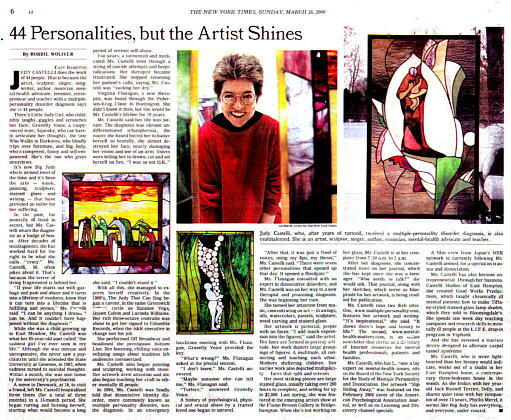

Read the transcript below:
44 Personalities, but the Artist ShinesBy ROBBIE WOLIVER JUDY CASTELLI does the work of 44 people. That is because the artist, sculptor, singer, songwriter, author, musician, mental-health advocate, inventor, entrepreneur and teacher with a multiple-personality disorder diagnosis says she is 44 people. There's Little Judy Girl, who childishly laughs, giggles and scrunches her face; Gravelly Voice, a raspy-voiced man; Squeaky, who can barely articulate her thoughts; the One Who Walks in Darkness, who blindly trips over furniture, and Big Judy, who's competent, funny and self-empowered. She's the one who gives interviews. It's now Big Judy who is around most of the time and it's been the arts - music, painting, sculpture, stained glass and writing - that have provided an outlet for her suffering. in the past, the mentally ill lived in secret, but Ms. Castelli wears the diagnosis as a badge of honor. After decades of misdiagnoses, she has worked hard for the right to be what she calls. "crazy." Ms. Castelli, 50, often jokes about It. That's because the terror of living fragmented is behind her. "If your life starts out with garbage and pain and abuse and it turns into a lifetime of madness, know that it can turn into a lifetime that is fulfilling and joyous," Ms. Castelli said. "I can be anything I dream can be. And It couldn't have happened without the diagnosis." While she was a child growing up In East Meadow, Ms. Castelli was what her 95-year-old aunt called "the saddest girl I've ever seen in my life." Although she was morose and unresponsive, she never saw a psychiatrist until she attended the State University at Geneseo, in 1967, when sadness turned to suicidal thoughts. Within a month, she was sent home by the university's psychiatrist. A move to Denmark, at 18, to visit a friend, left Ms. Castelli hospitalized three times (for a total of three months) in a 13-month period. She began cutting and burning herself, starting what would become a long period of serious self-abuse. For years, a tormented and medicated Ms. Castelli went through a string of suicide attempts and hospitalizations. Her therapist became frustrated. She stopped returning her patient's calls, saying Ms. Castelli was "sucking her dry." Virginia Flanagan, a new therapist, was found through the Pedersen-Krag Clinic in Huntington. She didn't know it then, but she would be Ms. Castelli's lifeline for 19 years. Ms. Castelli said her life was torture. The diagnosis was chronic undifferentiated schizophrenia; the voices she heard forced her to batter herself so brutally, she almost destroyed her face, nearly damaging her vision and use of an arm. Voices were telling her to drown, cut and set herself on fire. "I was so not O.K.," she said, "I couldn't stand It." With all this, she managed to express herself creatively. In the 1980's, The Judy That Can Sing began a career, in the same Greenwich Village circle as Suzanne Vega, Shawn Colvin and Lucinda Williams. Her rich three-octave contralto was about to get her signed to Columbia Records, when the A&R executive in charge lost his job. She performed Off Broadway and headlined the prestigious Bottom Line. Her booming, chilling voice enveloping songs about madness left audiences mesmerized. Ms. Castelli also began painting and sculpting, working with stone. Her artwork drew attention and she also began teaching her craft to other mentally ill people. In 1994, Ms. Castelli was finally told that dissociative identity disorder, more commonly known as multiple personality disorder, was the diagnosis. In an emergency lunchtime meeting with Ms. Flanagan, Gravelly Voice provided the key. "What's wrong?" Ms. Flanagan asked at the pivotal session. "I don't know," Ms. Castelli answered. "Maybe someone else can tell me," Ms. Flanagan said. "Torture," answered Gravelly Voice. A history of psychological, physical and sexual abuse by a trusted loved one began to unravel. "After that, it was just a flood of voices, using my lips, my throat," Ms. Castelli said. "There were seven other personalities that opened up that day. It opened a floodgate." Ms. Flanagan consulted with an expert in dissociative disorders, and Ms. Castelli was on her way to a new therapist and promising diagnosis. She was beginning her cure. She turned her attention from music, concentrating on art - drawings, oils, watercolors, pastels, sculpture, wood carving and stained glass. Her artwork is pictorial, people with no faces. "I add much expression into the figures," said the artist. Her lines are formed to portray attitude. Her work depicts large groupings of figures. A multitude, all connecting and touching each other. Mothers sheltering children. Her earlier work also depicted multiplicity - faces that split and scream. Her most striking pieces are large stained glass, usually taking over 200 hours to complete, and selling for up to $2,000. Last spring, she was featured in the emerging artists show at the Elaine Benson Gallery in Bridgehampton. When she's not working on her glass, Ms. Castelli is at her computer from 7:30 a.m. to 2 a.m. After her diagnosis, she concentrated more on her journal, which she has kept since she was a teenager. "Who needs to talk?" she would ask. That journal, along with her sketches, which serve as blueprints for her artwork, is being readied for publication. Ms. Castelli runs two Web sites. One, www.multiplepersonality.com, features her artwork and writing. "It's inspirational," she said. "It shows there's hope and beauty in life." The second, www.mental-health-matters.com, is an online newsletter that serves as a directory of Internet resources for mental health professionals, patients and families. Ms. Castelli, who has become a lay expert on mental-health issues, sits on the Board of the New York Society for the Study of Multiple Personality and Dissociation. Her artwork "Slip Sliding Away," was featured on the February 2000 cover of the American Psychological Association Journal, as well as on Learning and Discovery channel specials. A film crew from Japan's NHK network is currently following Ms. Castelli around, for a special on trauma and dissociation. Ms. Castelli has also become entrepreneurial. Through her business, Castelli Studios of East Hampton, she created Good Works Productions, which taught chronically ill mental patients how to make Tiffany-styled stained-glass lamp shades, which they sold to Bloomlngdale's. She spends one week day teaching computer and research skills to mentally Ill people at the L.I.F.E. Drop-In program in Yaphank. And she has invented a traction device designed to alleviate carpal tunnel syndrome. Ms. Castelli, who is more lighthearted than her history would indicate, works out of a studio in her East Hampton home, a contemporary three-bedroom house In the woods. As she frolics with her year-old Jack Russell Terrier, Dolly, and shares quiet time with her companion of over 15 years, Phyllis Meryl, it seems like Big Judy has everything, and everyone, under control. |
Looking Inside: Life Lessons from a Multiple
Personality in Pictures and Words, by Judy Castelli
HOME TOP multiplepersonality.com
Copyright 1998-2004 Judy Castelli